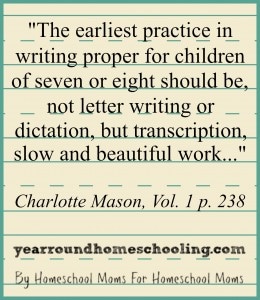I’m currently fighting working every so patiently with my 7 year old on his handwriting, the very beginnings of copywork. Lots of people talk about copywork. Do you ever wonder exactly why it’s recommended?

Copywork: What Is The Point?
Here is a quote from Charlotte Mason:
A Child should Execute Perfectly. No work should be given to a child that he cannot execute perfectly, and then perfection should be required from him as a matter of course. For instance, he is set to do a copy of strokes, and is allowed to show a slateful at all sorts of slopes and all sorts of intervals; his moral sense is vitiated, his eye is injured. Set him six strokes to copy; let him, not bring a slateful, but six perfect strokes, at regular distances and at regular slopes. If he produces a faulty pair, get him to point out the fault, and persevere until he has produced his task; if he does not do it to-day, let him go on to-morrow and the next day, and when the six perfect strokes appear, let it be an occasion of triumph. So with the little tasks of painting, drawing, or construction he sets himself––let everything he does be well done. An unsteady house of cards is a thing to be ashamed of. Closely connected with this habit of ‘perfect work’ is that of finishing whatever is taken in hand. The child should rarely be allowed to set his hand to a new undertaking until the last is finished. – Vol. 1, p. 160
Notice that she talks about having a child show his best efforts on a slate: a small chalkboard. Not many of us use chalkboards in our homeschools, I daresay, and I think they are all but obsolete even in public schools now. However, think about the way it feels to write with chalk on a chalkboard. There’s a lot of sensory input from the drag of the chalk moving over the surface of the slate, and it’s much easier to erase even than pencil. I am going to find our little chalkboard and have my son start using that for handwriting practice.
Copywork does a lot of good things for a student, but first and foremost, it needs to be done carefully with an expectation of perfection. I didn’t understand this for a long time; I thought my job was to have my children copy good quotes from excellent books and it would help them be better writers. It does do that, but above all, Charlotte Mason taught her students to observe. Everything she had them do was about teaching them to carefully observe the world around them. Copywork is part of that.
Copywork helps a great deal – an amazing amount – with spelling. Students first learn to transcribe words, which means they study a word, close their eyes and make a picture of it in their mind, and then write it down carefully. From there, they will progress to studied dictation, when they are given a passage to study. They are instructed to read the passage, note any words they are not sure of and make pictures of those words, spelled correctly, in their minds. Once they have had time to study the passage, a portion of it is dictated to them to write. I’ve used all kinds of spelling programs with my chi ldren, but nothing has worked like studied dictation.
ldren, but nothing has worked like studied dictation.
Copywork also exposes children to great writers, and that is why it’s so important to choose copywork selections from living books written in beautiful language. They should only copy what you want them to internalize. Later, when they are older, they choose their own passages to transcribe into their Commonplace Book – a book of their favorite poems, quotes, perhaps an interesting word definition. They will write anything that speaks to their heart, anything they want to remember. Help them choose carefully in the early years.
As I’ve written this, and done research (again) on the hows and whys of copywork, I realized that I’ve been pushing my son WAY too fast with his handwriting. I have been trying to have him write sentences, and he’s not even reading on his own. His letters are FAR from perfect. From today, we will take a step back, work carefully on creating beautiful handwriting, and wait a while longer on the rest.
How do you use copywork in your homeschool?
